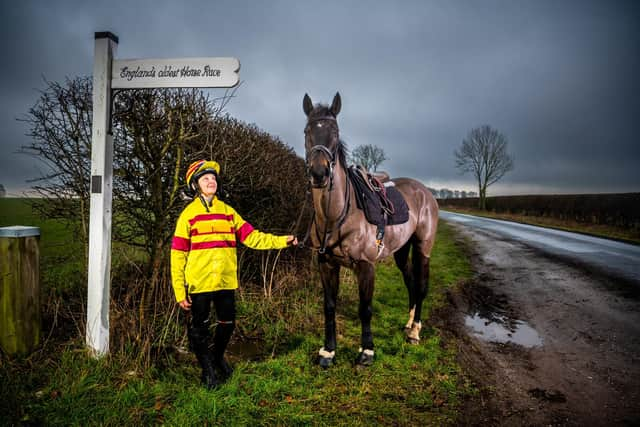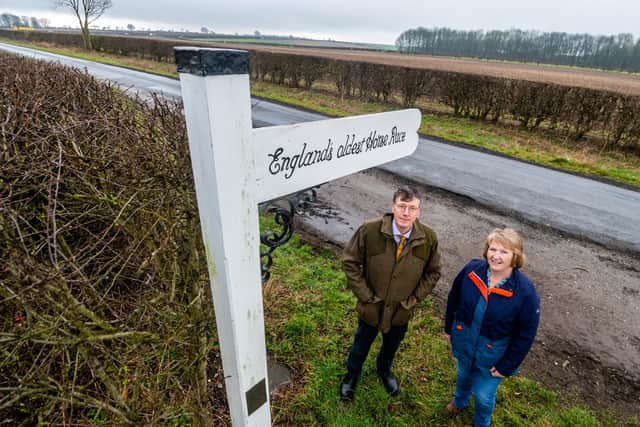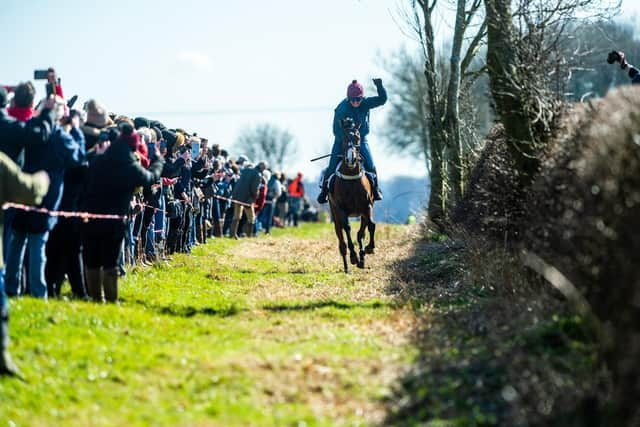Kiplingcotes Derby: The quirky horse race that has been run in the Yorkshire Wolds for over 500 years
Kiplingcotes Derby, run between Etton and Londesborough Wold, is the world’s oldest horse race having reputedly first been run in 1519 and will be competed for once again this coming Thursday 16 March.
Nobody knows who is taking part until they turn up at the winning post for the jockeys to be weighed-in and from there all entries have to make their way along the straight four-mile distance, predominantly using green lanes and grass verges to the start that is marked by a stone.
Advertisement
Hide AdAdvertisement
Hide AdPhilip Guest, whose family own local jewellery shops in Beverley and Pocklington and who lives at Everingham Hall, is one of the race’s trustees with Claire Waring, daughter of long-time former trustee Guy Stephenson. Philip has been involved with Kiplingcotes Derby for 20 years and said he is looking forward to a race that meets the original description of steeplechasing, although without the jumping normally associated with steeplechasing.


“Point to Pointing has now become a racecourse thing often set in somebody’s parkland as circuit course and over jumps. Kiplingcotes was the origin of Point to Pointing, run from a point to another point, from church steeple to church steeple, hence steeplechasing.
“Kiplingcotes begins from the back of Dalton Park, where there is a very clear spire, but strangely it ends in the middle of nowhere. I’ve never been able to work out why it would just end in the most nondescript place ever.
Philip said a chance meeting with someone inextricably linked with Kiplingcotes had snared him.
Advertisement
Hide AdAdvertisement
Hide Ad“I had been aware of Kiplingcotes for many years, but it was talking to Lady Jane Bethell one day that triggered my interest. The Bethell family has been involved since its inception and Harriet Bethell won in 2005. My wife keeps horses too.


“In the course of our conversation I discovered that the race trophy had disappeared, lost in the mists of time. I was in touch with Guy Stephenson whose farm runs alongside the finish line and was trustee of the race for a long period and offered through the business to sponsor the trophy and have a new trophy made.
The silver horse on a plinth was produced, co-sponsored with the trustees, and has been presented to the winner since 1999. Philip said that providing the new trophy brought about his over 20 year commitment.
“That drew me into it and I joined Guy with the organisation of the race. It is a very basic race run on grass verges with part of it being green lane. It is just one race with spectators literally standing on a verge leading up to and around the finish post, in the middle of nowhere.
Advertisement
Hide AdAdvertisement
Hide Ad“The jockeys have to turn up and weigh-in by 11 o’clock. They then weigh-in at finish. They have to weigh at least 10 stones on both occasions. If they don’t make the weight on the initial weigh-in they have to carry to make it up.


“The Clerk of the Course, Sue Hillaby who took over from her father, reads the rules which include that they must not strike another rider or commit foul play. Back in those early days there may possibly have been reason for this rule. These days it is much more civilised although still competitive. Sue’s husband Richard is the race starter.
Serial winners include Ken Holmes, who won a record 10 times between 1983 and 2002, and four consecutive races from 1992-95 on Tulum; Jean Cole-Walton, who won six times between 1967-74; Yvonne Robson, four times between 1951-57; John Thirsk, four times from 2008-12; and most recently Tracey Corrigan, winning four times from 2014-19.
Philip said the race is a test of stamina and a horse’s fitness, being held over 4 miles.
Advertisement
Hide AdAdvertisement
Hide Ad“Unlike Point to Pointing the race is a flat race rather than over jumps, but no less arduous as it is a mile longer than a Point to Point.
“It’s quite a long ride as all runners have to travel the entire length of the course to get to the start. You need a reasonably fit horse, because it is still a decent pace going down to the start and then a gallop back.
“Some just come for the experience and to play their own part in the race’s history. We’ve had people on little ponies, heavy horses, in fancy dress. In 2019 we had a big field for the race’s 500th but every year you just never know who will be coming, because there are no entry requirements.
“People often ask whether they have to qualify. I tell them they don’t, you just have to turn up, sign in, present yourself. Sue reads the rules and then it’s a canter down to the start.
Advertisement
Hide AdAdvertisement
Hide Ad“It attracts the more racehorse type, rather than hunters. A heavy hunter would struggle to gallop for such a long period of time, but everyone takes part because it is a slice of history. Sally Hill won last year.
There have been times when the race has been under threat of not taking place either because of the weather, disease restrictions or because public services such as local policing were no longer to be provided, but such is the commitment that this oldest of horse races continues.
In 1875 a race veteran is quoted, “We have sometimes had to cut through snow, seven or eight feet thick for a passage for the horses to run, but we have always had our race.” In 1947 Fred Stephenson was the lone participant on Londesborough Lad through four-foot snow drifts; in the Foot and Mouth epidemic year of 2001 Stephen Crawford was the lone participant on the course with his horse Memorable.
Philip said that when the police weren’t prepared to be involved anymore, providing traffic services, particularly near the end of the race as it crosses the main road from Holme on Spalding Moor to Driffield, there was a move to shut the whole thing down for safety reasons.
Advertisement
Hide AdAdvertisement
Hide Ad“It was in the early 2000s. I asked the inspector whether he wanted to be responsible for closing down the oldest horse race in England, because they were not being terribly helpful at that time.
“Concessions were made and the highways department of East Riding County Council has been helpful. We managed to get a traffic management company A-Plant to sponsor road signage and traffic lights. We also have Portaloos now, but that’s about as far as our facilities go.
“We rely on a group of pals who come and stand on lonely lane corners. Their reward is a nice long lunch at Everingham Hall with the trustees and helpers.